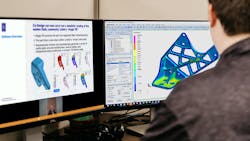Simulation Gets Designers Started on a Digital Workflow
Major manufacturers are global organizations because they must compete for business opportunities everywhere – and that also means they must avail themselves of the most skilled engineers and technicians that the world offers. In recent years, these global organizations have embraced digitalization as a way to streamline the process of collecting and applying all that intelligence.
As it turns out, casting simulation capabilities are useful to manufacturing organizations, even those that are not casting the parts.
Rolls-Royce is not only a major manufacturer of aerospace engines but also a designer of hundreds of the component parts and systems for those engines. While Rolls relies on various suppliers, its own engineers are responsible for parts design, and that gives it even more reason to embrace digitalization. And in this case, casting simulation.
When problems emerge during production planning or even after manufacturing has begun, the resolution may send Rolls’ designers back to the CAD – which slows progress and can drive up program costs. The problem may be more likely to occur in the course of lightweighting components or streamlining system designs, which is an objective for aerospace, automotive, and various other manufacturing programs.
Reportedly, Rolls-Royce engineers have adopted a “digital first” approach, meaning physical prototyping and testing are deemphasized in favor of a digital workflow based on ESI Group’s ProCAST casting simulation software. As reported by the software developer, Rolls-Royce materials and process modelling engineer Nick Calcutt described this digitalization effort as a “smart customer” approach.
Rolls-Royce engineers have adopted this approach as a pathway to expedite parts’ designs from the concept stage to the start of production, anticipating and avoiding potential problems that may result from new shapes or materials, or even with a new casting supplier. They work to design the part by incorporating details that will be necessary for the manufacturer to address – a so-called Design for Manufacturing (DfM) approach.
ProCAST software functionality offers Rolls engineers to share a “co-design workflow”: this makes their aerospace design and manufacturing experts more proactive and supportive to the parts producers. Rolls’ engineers can incorporate their co-design workflow results in the DfM efforts, so that they can identify things like thickness and porosity defects, or comparable manufacturability problems, before the design is sent to the casting supplier. This means the design team can evaluate potential solutions, even anticipating the cost of rework, early in the manufacturing process development.
For example, the Rolls-Royce design engineers are able run a cooling simulation they call “Magic Fill” on their casting designs. This process quickly predicts finished castings’ properties after the pouring and cooling.
Calcutt’s design team also can be more responsive to manufacturing issues that develop after the design has been finalized and the casting program has been assigned, i.e., recurring casting defects. Using ProCAST software, the co-design workflow means it’s possible to locate causes quickly and define corrective steps, either to the part geometry or the casting process.
“With a simulation run of around ten minutes, our newly implemented co-design workflow gives us the ability to locate 97% of potential casting issues associated with designs,” according to Calcutt. “It is accessible to most engineers, not only FEA simulation specialists. It would be difficult to justify why you wouldn’t run a co-design simulation, especially for large and/or expensive cast parts.”
